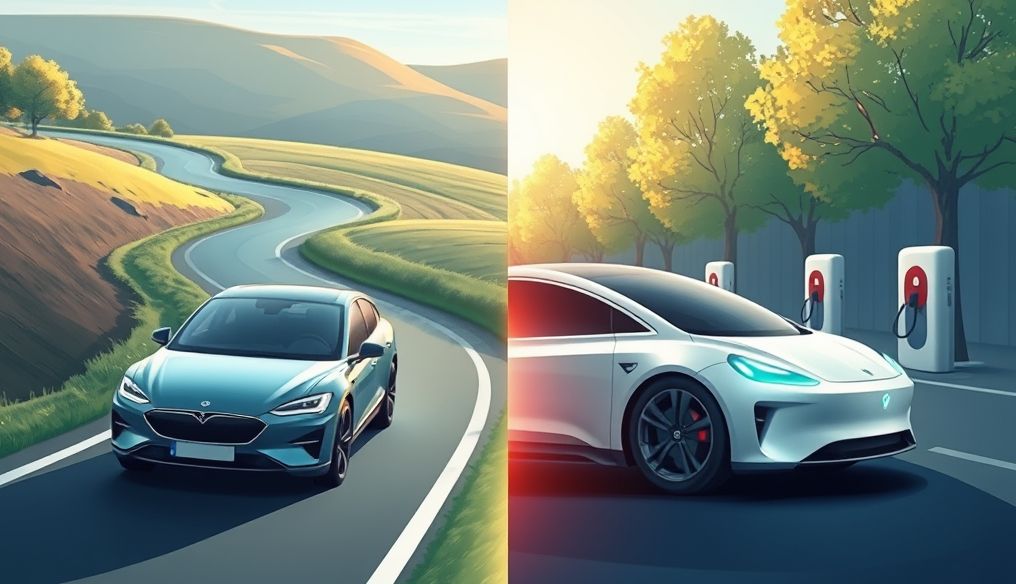Introduction: The Future of Transportation – Hybrid vs. Electric
In a world undergoing a rapid shift towards sustainability, hybrid and electric cars are emerging as promising solutions to reduce carbon emissions and improve air quality. However, with multiple options available, it can be challenging to determine which type of car is best for you. This article will clarify the fundamental differences between the two, considering aspects such as performance, cost, charging infrastructure, and environmental impact.
1. What is a Hybrid Car?
A hybrid car combines an internal combustion engine (usually gasoline) with an electric motor. Both engines work together to provide power, reducing fuel consumption and emissions. There are different types of hybrid cars:
- Mild Hybrid: Uses the electric motor to assist the main engine and reduce the load on it, but cannot move on electricity alone.
- Full Hybrid: Can move on electricity alone for short distances at low speeds, increasing fuel efficiency.
- Plug-in Hybrid (PHEV): Can be charged from an external electrical source, allowing it to travel longer distances on electricity alone compared to a full hybrid.
Example: The Toyota Prius is a classic example of a full hybrid car, while the BMW i8 was an example of a plug-in hybrid (PHEV).
2. What is a Fully Electric Car?
A fully electric car (Battery Electric Vehicle - BEV) relies entirely on electricity as a power source. It has no internal combustion engine and relies on a large battery to power the electric motor. The battery is charged from an external electrical source.
Example: The Tesla Model 3 and Nissan Leaf are among the most popular fully electric cars.
3. Key Differences: A Detailed Look
The following table summarizes the key differences between the two types of cars:
| Feature | Hybrid Car | Fully Electric Car |
|---|---|---|
| Power Source | Internal Combustion Engine + Electric Motor | Electric Motor Only |
| Emissions | Lower than traditional cars, but still produces emissions | Zero emissions (during operation) |
| Charging | Does not require charging (mild and full hybrids), or requires charging from an external source (plug-in hybrids) | Requires charging from an external source |
| Driving Range | Longer than electric cars due to the presence of the internal combustion engine | Shorter, but continuously improving with battery technology advancements |
| Operating Cost | Lower than traditional cars, but may be higher than electric cars | Lower due to the lower cost of electricity compared to gasoline |
| Maintenance | May be higher due to the presence of two engines | Lower due to fewer moving parts |
4. Performance and Driving Experience
Hybrid Cars: Offer a combination of power and efficiency. The electric motor can provide instant torque, improving acceleration. The ride is smooth and quiet, especially when using the electric motor only.
Fully Electric Cars: Feature instant acceleration and superior quietness. The ride is enjoyable and comfortable, with no vibration or engine noise.
5. Charging Infrastructure
Hybrid Cars: Do not rely heavily on charging infrastructure (except for plug-in hybrids), as they can rely on the internal combustion engine when needed.
Fully Electric Cars: Require a robust charging infrastructure. Public charging stations are available in many cities, and the car can also be charged at home using a home charger.
6. Cost: Purchase, Operation, and Maintenance
Purchase Cost: Hybrid cars are typically less expensive than fully electric cars, but plug-in hybrids may be more expensive.
Operating Cost: Fully electric cars are cheaper to operate due to the lower cost of electricity compared to gasoline. They also benefit from tax incentives in many countries.
Maintenance Cost: Fully electric cars require less maintenance due to fewer moving parts. They do not need oil changes or air filters.
7. Environmental Impact: Beyond the Exhaust
Hybrid Cars: Reduce emissions compared to traditional cars, but still produce emissions. The environmental impact depends on the efficiency of the engine and the type of fuel used.
Fully Electric Cars: Produce no emissions during operation, improving air quality in cities. However, the emissions from the production of electricity used to charge the battery must be considered. If the electricity comes from renewable sources, the environmental impact is much lower.
8. Which One is Right for You?
Choosing the right car depends on your needs and circumstances:
- If you drive long distances regularly: A hybrid car may be a better option, as you don't have to worry about range or the availability of charging stations.
- If you drive mostly in the city: A fully electric car may be a better option, as you can benefit from zero emissions and low operating costs.
- If you are looking for a compromise: A plug-in hybrid car may be a good option, as you can drive on electricity in the city and use the internal combustion engine for long trips.
- If you are very concerned about the environment: A fully electric car is the best choice, as long as you use clean electricity.
9. The Future of Cars: Towards Full Electrification?
The general trend is towards full electrification. Governments and companies continue to invest in developing battery technology and charging infrastructure. Fully electric cars are expected to become more common and affordable in the near future.
10. Tips When Choosing Between the Two
- Define your needs: How far do you drive daily? Where do you drive mostly? What is your budget?
- Test drive: Try driving both cars to see which one suits your driving style.
- Look for tax incentives: Check the tax incentives available in your country or region.
- Consider insurance costs: Insurance costs may vary between the two cars.
- Read reviews: Look for expert and other user reviews to get a better idea of each car's performance and reliability.
Conclusion: Hybrid and fully electric cars represent the future of sustainable transportation. Choosing the right car depends on your individual needs and priorities. Whether you choose a hybrid or a fully electric car, you are contributing to reducing emissions and improving air quality.




